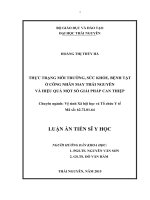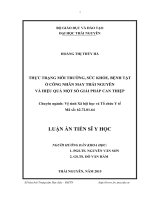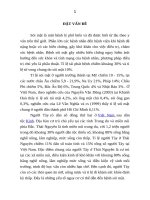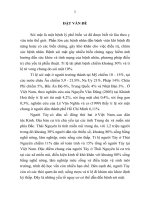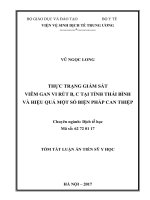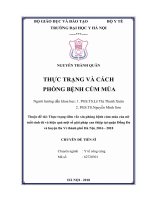Thực trạng môi trường, sức khỏe, bệnh tật ở công nhân may thái nguyên và hiệu quả một số giải pháp can thiệp (TT)
Bạn đang xem bản rút gọn của tài liệu. Xem và tải ngay bản đầy đủ của tài liệu tại đây (705.33 KB, 27 trang )
1
BỘ GIÁO DỤC VÀ ĐÀO TẠO
ĐẠI HỌC THÁI NGUYÊN
HOÀNG THỊ THÚY HÀ
THỰC TRẠNG MÔI TRƯỜNG, SỨC KHỎE,
BỆNH TẬT Ở CÔNG NHÂN MAY THÁI NGUYÊN
VÀ HIỆU QUẢ MỘT SỐ GIẢI PHÁP CAN THIỆP
Chuyên ngành: Vệ sinh Xã hội học và Tổ chức Y tế
Mã số: 62.72.01.64
TÓM TẮT LUẬN ÁN TIẾN SĨ Y HỌC
Thái Nguyên, năm 2015
2
CÔNG TRÌNH ĐƯỢC HOÀN THÀNH
TẠI TRƯỜNG ĐẠI HỌC Y DƯỢC - ĐẠI HỌC THÁI NGUYÊN
NGƯỜI HƯỚNG DẪN KHOA HỌC:
1. PGS.TS. Nguyễn Văn Sơn
2. GS.TS. Đỗ Văn Hàm
Phản biện 1:
Phản biện 2:
Phản biện 3:
Luận án được bảo vệ trước Hội đồng chấm luận án cấp Đại học
tại Trường Đại học Y dược – Đại học Thái Nguyên
Vào hồi giờ, ngày tháng………. năm 2015
Có thể tìm hiểu luận án tại:
- Thư viện Quốc gia
- Trung tâm học liệu Đại học Thái Nguyên
- Thư viện Trường Đại học Y - dược Thái Nguyên
3
INTRODUCTION
Weave and Garment are formed and developed from earlier.
How ever, up to now, working condition have been existed risk
factors to workr’s health. Researchs of specialists from all over the
world show that: working environment and worker’s health in weave and
garment industry have characteristic in compare to others. The
researchs of Bianna D, Ganer A, Boha S; Denis Hadjiliadis (2013-2014)
on weave and garment workers in Bangladesh and Pennsylvania,
Philadelphia (USA) are acknowledged that: disadvantageous environmental
microclimate, dust polluted and the rate of many diseases are
increasing, especially respiratory disease.
Researchs in Vietnam are acknowledged many related diseases to
weave and garment workers, especially respiratory disease (60 to 80%).
Have no perfect and systematical researchs in Thainguyen are
conducted on working place, occupational safety and health on
garment workers. Intervention researchs for health care, prevention to
related diseases on garment worker had been no ever. So that we
have been conducted the theme: “The real situation of environment,
health, diseases in Thainguyen garment workers and effect of
intervention ” aiming at:
1. Describe the status of environment, health, diseases in
Thainguyen garment workers in year 2012.
2. Analyses relative factors to health and diseases on
Thainguyen garment workers
3. Evaluate the effectiveness of intervention for occupational
safety and health in Thainguyen garment workers.
4
NEW CONTRIBUTIONS OF THE DISSERTATION
1. The dissertation has identified the real disadvantageous
situation of Thainguyen garment workers’s working environment:
some environmental factors exceeded permissible exposure limits
(PEL) such as 30-50% of temperature samples; 20-30 of dust
samples. The rate of good knowledge, attitude and practice on
occupational heath and safety of workers are low (61-75%).
Thainguyen garment workers’s health not good: The rate of
weak health is high (4.6%); The high rate of nose- throath (TN)
diseases was found (67.69% to 76.20%); The rate of bronchitis is:
4.23% to 9.6%; The rate of bysinosis is: 2.31% to 2.92%).
Some relative factors to Thainguyen garment workers’s health
and diseases were found: occupational ages, practice on occupational
heath and safety, dust polluted and using mask.
2. Solutions for intervention have been proposed for worker’s
health care, making high effect: diseases on repiratory tract in
Thainguyen garment workers are decreasing:
- The rate of good knowledge, attitude and practice on
occupational heath and safety of workers about prevention for
diseases on repiratory tract is increasing; Effect of Interventions to
knowledge is 52.7%, to attitude is 61.94%, to practice is 76.96% .
- Interventions made decreasing brochitis; The incident rate of
acute repiratory tract infection is decreasing.
- The model of intervention have been received supporting and
cooperating from communities (Employers and employees),
maintained and enhanced in garment industry.
5
STRUCTURE OF DISSERTATION
The key part of the dissertation is 110 pages, including the
following parts:
Introduction: 2 pages
Chapter 1. Literature review: 27 pages
Chapter 2. Subjects and method: 19 pages
Chapter 3. Results: 29 pages
Chapter 4. Discussion: 20 pages
Conclusions and recommendations: 3 pages
The dissertation has 106 references, including 76 Vietnamese
and 30 documents in English. The dissertation includes 38 tables, 7
diagrams on quantitive results and 7 boxes for qualitative results.The
appendix includes 8 subappendices with 14 pages.
Chapter 1. LITERATURE REVIEW
1.1. Environment, health and diseases of workers
About the environment, health and diseases of worker were
conducted by many researchs. However the problem of unshakcable
development and occupational safety and health of enterprises
become very importance. USA industry is in the first ranges of the
world, but have being disadvantageous working environment, for
example dust polluted, many factors exceeded permissible exposure
limits. Working environment of weave and Garment workers in Asia
were polluted by mix compound (organic and nonorganic) dust,
disadvantageous microclimate. It’s risk factors for worker’s health.
Results of some resarchs showed: 60% of weave and Garment
workers exposed to risk factors (with forced position) suffering
disease in muscle, bone and rheumatic.
6
By Nguyen Huy Dan, Nguyen Duy Bao ( National Institute of
Occupational and Environmental Health) in year 2012, pollution by
ocotton dust in working place and surrounded areas of weave and
garment enterprises always risky and must be concerned. How to
resolve? Need to be intervention by solutions how to decreasing
environmental pollution, health care and preventing occupational
disease of workers.
1.2. Affective factors to health and disease of worker
Earlier from XVIII century, while the light industry had been
developed in European, many researchs concerning about time of
exposure to occupational risk factors and diseases in Engglish’s
weave and garment industry. Especially in the first half of XX cetury,
while the weave and garment industry had been developed, many
relative risk factors affect to worker’s health and relative,
occupational diseases had been determimed.
In last ten years at XX cetury, many researchs about impact of
working environment, physiology, biochemistry, clinical
occupational disease have been conducted. Researchs in other fields
were developed but have non matching suitability, therefore it is low
effect for solutions to protect harmfulness, health care and preventing
the occupational diseases of worker in many countries.
1.3. Intervention research for decreasing the harmfulness, protect
and enhancement of worker’s health, preventing the occupational
accident and disease
From the last of XX cetury scientists in over the world have been
researched focus to 2 orientations: environmental impact assessment and
intervention for environmental improve and health protection.
Asia-Pacific Occupational Safety and Health Organization
(APOSHO) have been orienting the health care of worker in the first
half of XXI century is preciding Occupational Safety and Health,
7
health care, preventing accident, occupational disease of workers by
any ways, how to coincide to eco-social condition of the each country
(The 23
Th
of APOSHO council’s resolutions, year 2007 in
Singapore). Research about labor and health care on garment worker
in Bangladesh (2013), Me Huq, MR Rahman, S Shermin, et all
showed that: 93% workers being tired, so that leading to exhaust after
work. Authors recommended about solutions for improvement of
working environment and primary health care to workers, especially
solutions how to make up for health’s losses, enegy’s restablish.
It was not many of researchs concerning to garment worker’s
health care in our country, especially intervention studies. About
solutions for worker’s health care in general, in particular of garment
worker, Scientists and employers show that: It is very important for
combinative suitable solutions from communication, health care,
technic for occupational safety and health.
Chapter 2. SUBJECTS AND METHODS
2.1. Study subjects
2.1.1. Enterprises: Describe about working environment
Active choice 03 garment companies, enterprises have
characteristic engineering processing of Thainguyen garment industry.
Garment, cut, accomplish worshops of enterprises were chosen.
2.1.2. Employers and employees
Garment workers direct - exposing to relative, risk factors were
chosen. Group of wokers doing in characteristic environment and
occupation, garment relative factors are being chosen.
For intervention study to health protection and health care:
- Intervention group: Garment workers are doing direct
exposure to engineering processing of TDT Company.
8
- Control group: Garment workers are doing direct exposure to
engineering processing of Chienthang garment enterprise.
2.2. Study setting and duration
2.2.1. Study setting 03 garment company, enterprises were chosen:
Thainguyen garment company; Garment TDT Company and
Chienthang garment enterprise. In which, workers of Garment TDT
Company for intervention and workers of Chienthang garment
enterprise for control.
2.2.2. Study duration: From february 2012 to october 2014
2.3. Methodology
2.3.1. Study method and Design
There are two methods were applied in our research:
- Design of cross-sectional descriptive study: The study used
for describe the real situation of working environment, health,
diseases of workers, KAP about occupational health and health and
to determine related factors for health, disease ( For 1 and 2 study
subjects, before the intervention).
- Intervention study: Before - after intervention design with a
control group.
- Quantative study combined with qualitative study.
Qualitative design with In-depth interviews and focus group
discussions.
2.3.2. Sampling chosing method
2.3.2.1. Sampling method for descriptive study
* Sample size for a descriptive study: Calculated by the
following formula:
2
2
)2/1(
.
d
qp
n
Where: p = 0.3 ( Proportion of nose and throat acute infection)
taken from the study by Nguyen Dinh Dung (31.7%), d = 0.03, α = 0.05.
9
Substituting these into the formula and giving a value for n of
897 and is rounded up = 1000.
Sampling procedures: Active some workshops in choice 03
garment company. Workers were selected from lists of all by single
random method, how to fit 1000:
Thainguyen garment company: 500 workers
Garment TDT Company: 260 workers
Chienthang garment enterprise: 240 workers
* Sample size for environmental study and lung function
testing: Calculated by the following formula:
n= Z
2
1-α/2
2
2
s
( X )
Substituting into the formula and giving a value for n of lung
function testing is 76. In practice, grand total have 281 workers; n of
environmental study is 28 and in practice, grand total have 30 samples.
* Sampling method for intervention study
- Sample size for a intervention study: Calculated by the
following formula:
n = (Z
1-/2
+ Z
1-
)
2
1 1 2 2
2
12
()
p q p q
pp
Where Z
(1-α/2)
= 1.96, α=0.05
,
(1 )
Z
= 2.8, sample power is
80%, p
1
= 0.32 (Proportion of nose and throat acute infection) taken
from the study by Nguyen Dinh Dung (31.7%). p
2:
Proportion of nose
and throat acute infection after intervention decreasing additional
15%, so p
2
= 0.15. Substituting these into the formula and n is 94 and is
rounded up = 100 for both two groups. This sample size is the same for
KAP of occupational health and safety research and diseases.
Sampling procedures:
- Intervention group: 100 workers of garment TDT Company
10
- Control group: 100 workers of Chienthang garment enterprise.
2.4.2.2. Sampling method for a qualitative study
In-depth interviews and focus group discussions were
conducted 02 times before and after the intervention as follows:
- In-depth interviews: 3 in-depth interviews (02 before and 01
after the intervention).
- Group discussion: 04 Group discussions (02 before and 02
after the intervention).
2.4.3. Content of intervention
2.4.3.1. Organizable operation
Making the Directive committee of occupational health and
safety and prevention for respiratory diseases. Directive committee
was managed by Board of Directors and making active contents.
Health section chief and occupational safety persons are activist.
Director taking the responsibility president of labor protection
council is head of committee. Health section chief is sub-head of
committee, having responsibility being on duty and assistant board of
Directors all problems of occupational health and safety and
prevention for respiratory diseases inworkers.
2.4.3.2. Content of intervention
- Training and health communication of occupational safety
and health, health care, prevention occupational and relative diseases,
especially respiratory diseases of workers.
- Inspecting and guide workers in practice of using how to
rightly, permanently, effectively of personal protection. Guide
workers about improving and care of working environment.
- Using mask was putting in the first important position and
having permanent inspection.
- Combination with local committee, branch inspecting of
industrial medicine in oder to improve the intervention effect and
permanent preservation all intervention results in lasting.
11
- Periodic and non-periodic inspecting permanently on actions
of occupational health and safety and prevention for respiratory
diseases to garment workers in oder to find out mistakes and having
the plan to overcome in time. Members in Directive committee are
divided doing by turns the inspecting monthly.
2.4.5. Technique of data collection and processing
2.4.5.1. Technique of data collection
* Environmental examinations were coducted in two seasons
every years (winters and summers), how to assess exactly working
environment.
* Direct interview study subjects about individual information,
knowledge, attitude, practice of preventing respiratory diseases by
survey chek lists, had been designing by occupational health experts.
* Clinical examination for total by expert doctors ( Medical
Specialists of I degree or medical masters) in each departments by
special means and instruments: stethoscope, nose – throat illuminable
lamp, reflective hammer…
* Determinative dignose for respiratory diseases: base on standards
of VN Ministry of health, was published in year 2002 and ICD
10
.
* Quanlitative study: Direct interview by printed survey chek
lists up to study object. Focus group discussions: by groups of objects
on understand, concern and realization of solutions for preventing
respiratory diseases on garment workers. Quanlitative data was
analysed by process of explaination and converge, so that focus to
main problems.
2.4.5.2. Data processing and analyzing
Data were processed and analyzed by using Epi-info 6.04 and SPSS13.0.
To evaluate an intervention efficiency index and efficiency
index (EI) to compare indice before and after intervention in
intervention group.
12
Chapter 3. STUDY RESULTS
3.1. Real situation of working environment, knowledge, attitude,
practice of garment worker
Table 3.1. The rate of samples about working environmental
temperature exceeded Permissible Exposure Limits (PEL)
Index
Enterprises
Season
Temperature exceeded PEL
Numbers of test
Quantity
%
Chien
Thang
Hot
30
14
46.67
Cold
30
12
40.0
TĐT
Hot
30
13
43.3
Cold
30
10
33.3
TNG
Hot
30
15
50.0
Cold
30
11
36.67
Total
180
75
41.67
Vietnam Standard (VNS): 5508-1991
The rate of samples about working environmental temperature
exceeded PEL was high (41.67%). There are different rates in every
enterprises, shaking from 33% to 50%. It is characteristice, very
necessary in garment working environmental care.
Table 3.2. The rate of samples about effective temperature (Webb)
exceeded PEL
Index
Enterprises
Season
Webb exceeded PEL
Numbers of test
Quantity
%
Chien Thang
Hot
30
12
40.0
Cold
30
11
36.7
TĐT
Hot
30
11
36.7
Cold
30
10
33.3
TNG
Hot
30
13
43.3
Cold
30
11
36.7
Total
180
68
37.8
VNS: 5508-1991= (23
0
- 25
0
)
The rate of samples about working environmental effective
temperature exceeded PEL was high (37.8%). The disadvantageous
microclimate made bad affect in harmony of body temperature.
13
Table 3.3. The rate of samples about concentrated dust exceeded PEL
Index
Enterprises
Season
Concentrated dust exceeded PEL
Numbers of test
Quantity
%
Chien Thang
Hot
30
9
30,00
Cold
30
7
23,33
TĐT
Hot
30
8
26,67
Cold
30
6
20,00
TNG
Hot
30
8
26,67
Cold
30
7
23,33
Total
180
45
25.00
VNS: ≤ 1 mg/m
3
The rate of samples about concentrated dust in all enterprises
exceeded PEL was high (25.00%). The disadvantageous
microclimate made bad affect in harmony of body temperature.
Samples tests in hot season at all enterprises, exceeded PEL rate are
always higher than cold season (3% – 7%).
Box 3.1. The remarks of Trade-union organization about
working environment and health care for workers
In the interview with enterprise’s trade-union leader about
working environment and health care for workers. Mr. Do Ngoc T
– President of the Garment TDT Company Trade-union said that:
- Company Trade-union had known about dust polluted in
working environment is needs to concern. It is the risk factors to
spiratory diseases.
- Company Trade-union had known about the roles myself
but not enough doing in this field.
- Company Trade-union had concerned only to doing,
resting regime had non to occupational saferty and health.
14
Table 3.4. Training of occupational saferty and health to workers
Training
Enterprises
In begining
Periodic
Quantity
%
Quantity
%
Viet Thai (500)
217
43.40
203
40.60
Chien Thang (240)
96
40.00
91
37.92
TĐT (260)
113
43.46
105
40.38
Total (1000)
426
42.60
399
39.90
The rate of training only having 40%-43%, especially periodic
training having 39,9%. Compare on demand from ministry of labor,
it is not good rate.
Box 3.2. The role of occupational safety and medical cadres
about OSH, health care, preventing diseases for workers.
In group discussions meeting about the role of occupational
safety and health, health care and solutions for occupational
safety and health and preventing diseases for garment workers,
all opinions are focusing to some problems:
- All occupational safety and medical cadres of company had
learned about disadvantageous working environment,
occupational safety and health must be improve.
- Occupational safety and health not meet the needs by many
subjective and objective reasons, both from employees and
employers.
- About speciality, occupational saferty and health, medical
cadre in company said that: their knowledge and skill not
enough for worker’s health care and respond to occupational
safety and health.
15
3.3. Real situation of health, diseases and relative factors of
Thainguyen garment worker
Table 3.5. Categories of worker’s health (Quantity/ Q-tity and %)
Health
Enterprises
Category 1 &2
Category 3
Category 4 & 5
Q-tity
%
Q-tity
%
Q-tity
%
Viet Thai (500)
279
55.80
192
38.40
29
5.80
Chien Thang (240)
157
65.42
68
28.33
15
6.25
TĐT (260)
151
58.08
107
41.15
2
0.77
Total (1000)
587
58.70
367
36.70
46
4.60
The rate of good health (Categories I&II) in garment workers
is 58.7%, not good health (Categories IV&V) is 4.6%. Tran Danh
Phuong’s research on Tuynel workers was similar to our (3.7%). By
different authors, the normal rate of categories IV&V is 1.5 to 2.8%.
That’s why, the rate of categories IV&V in Thainguyen garment
workers is high.
Table 3.6. The rate of common diseases in workers
Enterprises
Diseases
Viet Thai
(500)
Chien
Thang (240)
TĐT
(260)
Total
(1000)
Q-tity
%
Q-tity
%
Q-tity
%
Q-tity
%
In nose
171
34.20
82
34.17
87
33.46
340
34.00
In throat
184
36.8
87
36.25
79
30.38
350
35.00
Total of nose
and throat
diseases
381
76.2
175
72.92
176
67.69
732
73.20
Bronchitic
48
9.60
22
9.17
11
4.23
81
8.10
Hypetention
31
6.20
16
6.67
15
5.77
62
6.20
Bone and joint
38
7.60
18
7.50
14
5.38
70
7.00
In skin
37
7.40
16
5.83
19
7.31
72
7.20
In digestive
14
2.80
6
2.50
8
3.08
28
2.80
Bysinosis
13
2.60
7
2.92
6
2.31
26
2.60
The rate of diseases in nose is 34.0% (33.46% - 34.20%),
Bronchitic is 8.1% (4.23-9.6%), Bysinosis is 2.6% (2.31-2.92%). In
compare with results of diseases in nose, throat and bronchitic,
researching by authors in Vietnam Weave and Garment Company it
is similar. It is difference to others industrial brands (At the same
time). On Tuynel workers, researching by Tran Danh Phuong: these
rates are about 48.2%.
16
Table 3.7. The rate of diseases in nose
Enterprises
Diseases
Viet Thai
(500)
Chien Thang
(240)
TĐT
(260)
Total
(1000)
Q-tity
%
Q-tity
%
Q-tity
%
Q-tity
%
Allergy
94
18.80
51
21.25
48
18.46
193
19.3
Acute infection
86
17.20
44
18.33
41
15.77
171
17.1
Chronical
infection
27
5.40
15
6.25
13
5.00
55
5.5
Others
28
5.60
14
5.83
17
6.54
59
5.9
The rate of diseases in nose was high (5.5% to 19.3%),
especially allergy and acute infection (17.1% to 19.3%). It is higher
to others researchs (At the same time). On Phuha leather and shoes
workers, researching by Nguyen Duc Trong, Nguyen Dinh Dung, Vu
Thi Ai: these rates are about 16%.
Table 3.8. The rate of diseases in brochia and lung to years of work
Diseases
Year of work
Numbers of
workers
Disease
Q-tity
%
2 - < 3 years (1)
273
5
1.83
From 3 - <5 years (2)
447
53
11.86
From 5 - 7 years (3)
280
49
17.5
Total
1000
107
10,70
p
p
(1&2)
< 0.05; p
(1&3)
< 0,05; p
(2&3)
< 0.05
The rate of diseases in brochia and lung of Thainguyen garment
workers is clear increasing by years of work. It is similar to others
researchs (By reports of domestic and foreign scientific conferences).
The rate of diseases to year of work in garment workers is the same.
17
Table 3.9. The rate of lung function disorder
Lung function
Enterprises
Numbers of
test
Lung function disorder
Q-tity
%
TĐT
144
19
13.19
Chien Thang
137
18
13.14
Total
281
37
13.17
The rate of lung function disorder is high (13.1%). It is similar
in two enterprises (13.14% - 13.19%). Lung function disorder is the
consequyent of diseases in respiratory track. So that, by our opinion:
it is the urgent problems, must be cocerning. Nowadays, intervention
studies for worker’s health care in practice of many industrial
branchs, protecting lung function is index of effective assessment.
Table 3.10. Relation of practice on occupational saferty and health
to lung function disorder (281 workers)
Disorder
Practice
Having
Not
Q-tity
%
Q-tity
%
Not good (179)
27
15.08
152
84.92
Good (102)
10
9.80
92
90.20
Total
p< 0,05
Bad practice on occupational saferty and health made increasing
the rate of lung function disorder, statistically significant (p<0.05).
Table 3.11. Relation of using standard mask (U.St Mask) to diseases
in nose and throat (732 patients)
Diseases
U.St Mask
Diseases (+)
Diseases (-)
Q-tity
%
Q-tity
%
Non- U.St Mask (157)
139
88.54
18
11.46
U.St Mask (843)
593
70.34
250
29.66
p
< 0,05
There are differeces about the rates of diseases in nose and
throat betwen two groups of using standard mask and non-standard
mask, statistically significant (p<0.05).
18
Table 3.12. Relation of using standard mask (U.St Mask) to diseases
in brochia and lung (107 patients)
Diseases
U.St Mask
Diseases (+)
Diseases (-)
Q-tity
%
Q-tity
%
Non- U.St Mask (157)
28
17.83
129
82.17
U.St Mask (843)
79
9.37
764
90.63
p
< 0,05
There are differeces about the rates of diseases in brochia and
lung betwen two groups of using standard mask and non-standard
mask, statistically significant (p<0.05). This relation is similar of
diseases in nose and throat in Thainguyen garment Workers. These
relations have been agreeableness and proposing for strict, perfect
using of this personal protective means.
Table 3.13. Relation of practice on occupational saferty and health
to diseases in nose and throat (732 patients)
Diseases
Practice
Diseases (+)
Diseases (-)
Q-tity
%
Q-tity
%
Not good (719)
621
86.37
98
13.63
Good (281)
111
39.50
170
60.50
p
< 0,05
There are differeces about the rates of diseases in nose and
throat betwen two groups of good pratice and not good pratice,
statistically significant (p<0.05). The rate of diseases in nose and throat
in good pratice group is 39.5%, in not good pratice group is 86.37%.
Table 3.14. Relation of practice on occupational saferty and health
to diseases in brochia and lung (107 patients)
Diseases
Practice
Diseases (+)
Diseases (-)
Q-tity
%
Q-tity
%
Not good (719)
83
11,54
636
88,46
Good (281)
24
8,54
257
91,46
p
< 0,05
There are differeces about the rates of diseases in brochia and
lung betwen two groups of good pratice and not good pratice,
statistically significant (p<0.05).
19
Table 3.15. Relation of dust pollution to diseases in nose and throat
(732 patients)
Diseases
Dust pollution
Diseases (+)
Diseases (-)
Q-tity
%
Q-tity
%
exceeded PEL (278)
237
82,25
41
14,75
Not exceeded PEL (722)
495
68,56
227
31,44
p
< 0,05
There are differeces about the rates of diseases in nose and
throat betwen two groups of good pratice and not good pratice,
statistically significant (p<0.05).
Table 3.16. Relation of dust pollution to diseases in brochia and
lung (107 patients)
Diseases
Dust pollution
Diseases (+)
Diseases (-)
Q-tity
%
Q-tity
%
Exceeded PEL (278)
38
13,67
240
86,33
Not exceeded PEL (722)
69
9,56
653
90,44
p
< 0,05
There are differeces about the rates of diseases in brochia and
lung betwen two groups of good pratice and not good pratice,
statistically significant (p<0.05).
3.4. Efficiency of solutions, intervention for occupational saferty
and health and health care on Thainguyen garment workers
Box 3.4. Assessment of Garment TDT Company Trade-union about
efficiency of solutions
Mr Do Ngoc T – President of Garment TDT Company Trade-
union assessing about intervention for occupational saferty and health
and preventing respiratory track diseases in interviews that:
- Occupational saferty and health and preventing
respiratory track diseases for garment worker were conducted
perfectly, suitable to need of company’s practice by Directive
committee.
- The time of doing with Directive committee, he more had
realized Trade-union’s roles and training rounds about
occupational saferty and health conducting befor were not
20
enough, no suitable to need of company’s practice, especially
have non solutions for preventing respiratory track diseases.
- After the advice and having effects of intervention from
Theme’s manager board, executive committee of Company
Trade-union and Director will be close joining for health care and
good occupational saferty and health.
Figure 3.1. Knowledge of occupational saferty and health after the
intervention(Effective Index and Intervention Effect/EI and IE )
- EI of TĐT: 55.93%; EI of Chien Thang:3.23%; IE: 52.7%
Figure 3.2. Attitude of occupational saferty and health after the
intervention
- EI of TĐT: 70.27%; EI of Chien Thang:8.33%; IE: 61.94%
Figure 3.3. Practice of occupational saferty and health after the
intervention
EI of TĐT: 47.06%; EI of Chien Thang:-29.63%; IE: 76.99%
59
92
62
64
0
20
40
60
80
100
TĐT (100) Chiến Thắng (100)
Trước CT/NC
Sau CT/NC
66
82
73
65
0
10
20
30
40
50
60
70
80
90
TĐT (100) Chiến Thắng (100)
Trước CT/NC
Sau CT/NC
63
89
64
67
0
20
40
60
80
100
TĐT (100) Chiến Thắng (100)
Trước CT/NC
Sau CT/NC
21
Box 3.5
. Assessment of occupational safety and medical cadres
group about efficiency of intervention to occupational safety and
preventing diseases
Group of cadres had been understanding many problems,
received useful documentaries, training.
Usually, timely make health care, supervise occupational
saferty and health were knowed in all cadres.
All occupational safety and medical cadres of
Thainguyen garment company had learned that: Knowledge and
behaviour of occupational saferty and health were improved.
Actions had been becoming effectiveness.
Table 3.17. Effect of intervention to acute infection in nose
Disease
Enterprise
Befor of
intervention
(Q-tity)
After of
intervention
(Q-tity)
EI (%)
TĐT (100)
18
14
22.22
Chien Thang (100)
16
17
-6.25
IE
28.47%
After the intervention, acute infections in nose are decreasing
in intervention group, EI = 22.2. Acute infections in nose are n’t
decreasing in control group. Intervention effect is 28.4%.
Table 3.18. Effect of intervention to
the incident rate of infection in nose
Disease
Enterprise
Befor of
intervention
(Q-tity)
After of
intervention
(Q-tity)
EI (%)
TĐT (100)
3
1
66.67
Chien Thang (100)
2
3
- 50
22
IE
116.6%
Effect of intervention to the incident rate of infection in nose
is clearing Intervention effect is 116.67%.
Figure 3.4. Effect of intervention to
the rate of chronic infection in nose
EI of TĐT: -7.12%; EI of Chien Thang:-58.33%; IE: 51.11%
Table 3.19. Effect of intervention to bronchitis
Disease
Enterprise
Befor of inter/
research
(Q-tity)
After of
inter/
research
(Q-tity)
EI (%)
TĐT (100)
6
5
16.67
Chien Thang (100)
9
10
-11.11
IE
27.78%
Effect of intervention to bronchitis is clearing. Intervention effect
is 27.78%.
Table 3.20. Effect of intervention to chronic bronchitis
Disease
Enterprise
Befor of
intervention
(Q-tity)
After of
interventio
n (Q-tity)
EI (%)
TĐT (100)
2/6
0/5
33.33
Chien Thang (100)
3/9
4/10
-6.67
14
15
12
19
0
5
10
15
20
TĐT (100) Chiến Thắng (100)
Trước CT/NC
Sau CT/NC
23
IE
40%
Effect of intervention to chronic bronchitis is clearing.
Intervention effect is 40%.
Table 3.21. Effect of intervention to bysinosis
(By Schilling R.S.F /1981)
Enterprise
Index
TĐT
Chien Thang
TCT
SCT
TNC
SNC
Q-tity of Bysinosis
3
3
2
3
Q-tity C
1
category
2
2
2
2
Q-tity of F
1
Lung
function disorder
2
1
2
2
Have 01 case of Bysinosis in control group. The rate of
category C
1
Bysinosis is similar in both two groups (After the
intervention). Lung function is improving in intervention group.
Box 3.6. Assessment of employees group about efficiency of
intervention to occupational safety and preventing diseases
- Training and guiding occupational safety and health for
workers are effectiveness. Group of employee had been
understanding that, traning of occupational safety and preventing
diseases is very important, they must be attend more often and
seriously.
- Employees clear understanding of occupational safety
and health, preventing diseases, how to make health care
themselves, after training and helping from researching group.
- Employees have proposed about maintenance this model,
training often, providing perfect personal protection, periodic
examining worker’s health accompanying with lung function
testing.
24
CONCLUSION
1. Real situation of working environment, knowledge, attitude,
practice of garment worker
1.1. Working environment and knowledge, attitude and practice on
occupational safety and heath of workers are not good:
- Effective temperature index exceeded PEL, 37.8%, in both 3
enterprise, from 33 to 43%.
- 25% of dust samples exceeded PEL.
- The rate of good knowledge, attitude and practice on
occupational safety and heath of workers was high: by order/ 61-
63%; 63-66%; 68-75%.
1.2.
Health, disease of Thainguyen garment workers are not good:
- The rate of 4&5 categories is 4.6%, 3 category is 36.7%, 1&2
categories is 58.7%.
- The rate of throat and nose acute infection is high (73.20%);
The rate of nose disease is 34%; The rate of throat disease is 35%.
- The rate of disease in bronchia is 8.1%.
- The rate of bysinosis is 2.6%.
- The rate of lung function disorder is 13.17%.
2. Relative factors to health and disease on Thainguyen garment
workers
- The rate of disease in throat and nose, bronchia and lung and
is increasing by years of work.
- The rate of lung function disorder is increasing by year of work.
- The rate of disease in throat and nose, bronchia, lung and
lung function disorder have clear relation to occupational safety and
heath, training, using perfect mask, statistically significant (p<0.05).
25
- The rate of disease in throat and nose, bronchia in
Thainguyen garment workers have clear relation to dust polluted,
statistically significant (p<0.05).
- The rate of disease in respiratory track in Thainguyen
garment workers have clear relation to using perfect mask, good
knowledge, attitude and practice on occupational safety and heath,
statistically significant (p<0.05).
3. Efficiency of solutions in intervention for occupational saferty
and health and health care on Thainguyen garment workers
- Diretive committee for occupational safety and heath,
preventing disease in respiratory track in Thainguyen garment
workers had been established and effective actively.
- Knowledge, attitude and practice on occupational safety and
heath, preventing disease in respiratory track in garment workers are
increasing after the intervention: intervention effect to knowledge is
52.7%; to attitude is 61.94% and to practice is 76.96%.
- Effect of Interventions to respiratory diseases is clear high:
respiratory diseases in Thainguyen garment workers are decreasing:
28.44% for acute infection in nose; 116,67% for incident infection in
nose; 51.11% for chronic infection in nose and 40% for acute series
of chronic bronchis.
- The model of intervention have been received supporting and
cooperating from employees and employers, maintained and
enhanced in garment industry.
RECOMMENDATIONS
From the results obtained, we make some recommendation:
